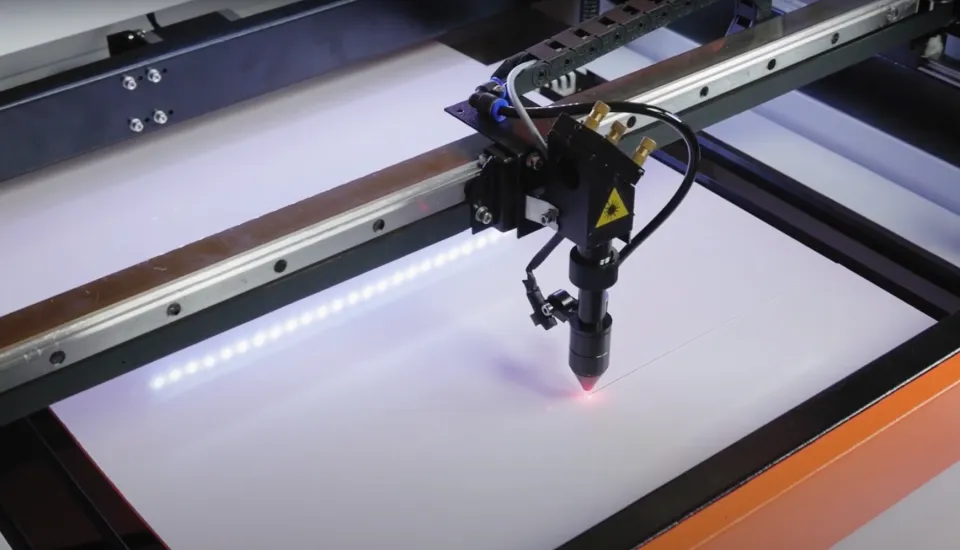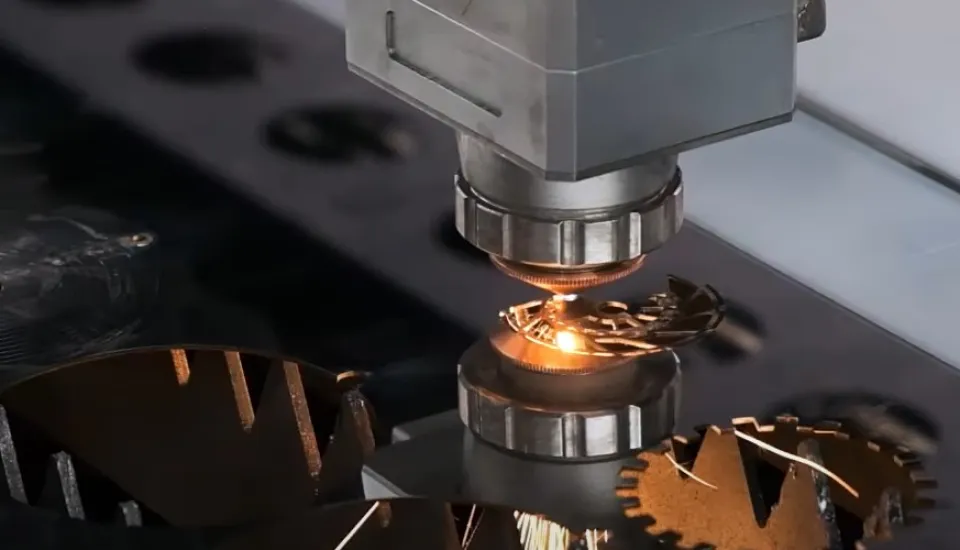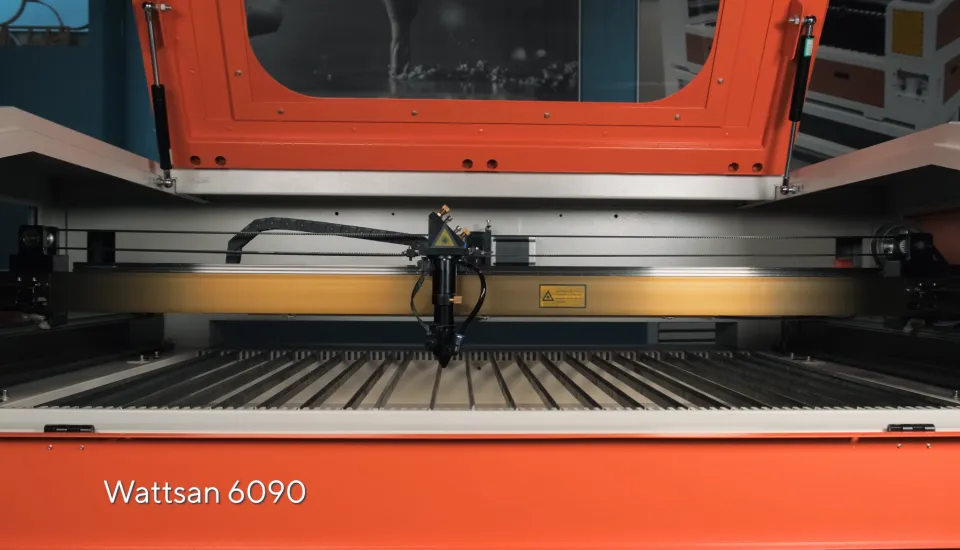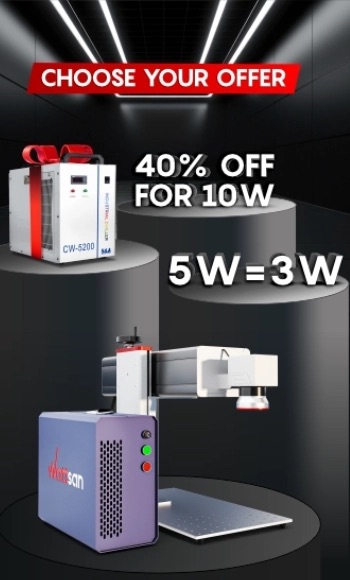If you decide to start production on a CNC laser cutting machine, you will inevitably face serious competition. Until 10-15 years ago, it was possible to make a fortune in laser cutting without much effort, even with lackluster results. But now everything has changed.
Today's laser cutting market is much more demanding when it comes to the quality of the end result.
Customers are no longer willing to buy plywood products with a burnt edge or metal products with drossed edges. The market is still highly lucrative, but to compete in this market, the choice of equipment must be taken seriously.
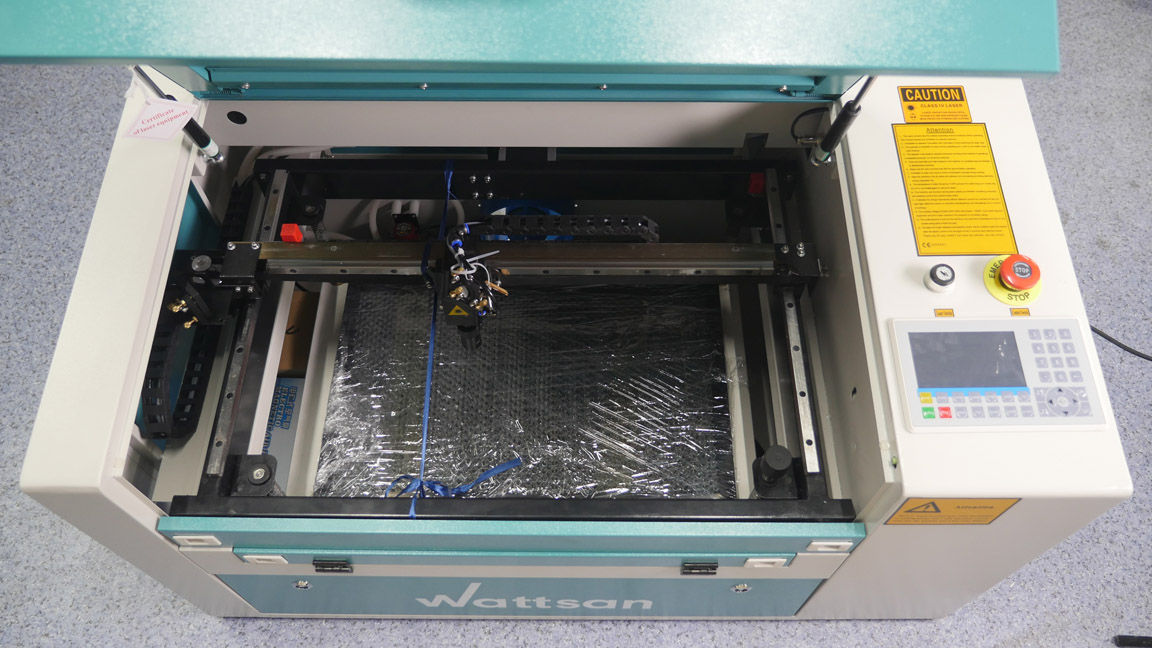
The CNC laser cutting machines market is overfull of similar CNC lasers with the same-type descriptions. Such equipment is expensive, and, before you purchase it, you need to figure out what to point out. And this article will help you with that.
CONTENTS:
Advantages of CNC laser cutting
What is produced with CNC laser cutting machines?
How to choose a laser cutting machine, basic criteria
- Laser source type
- Laser source power
- Work area size
- Reliability and durability of the machine frame, bed, and gantry
- Speed of operation
- Precision of all equipment units
- Complete equipment
- Software
- Supplier reliability and support
Top CNC lasers for cutting:
- plywood and wood-based materials,
- plastics,
- metals,
- universal cutter for different materials,
- textiles and roll-up materials.
Conclusion
FAQ
Advantages of CNC laser cutting:
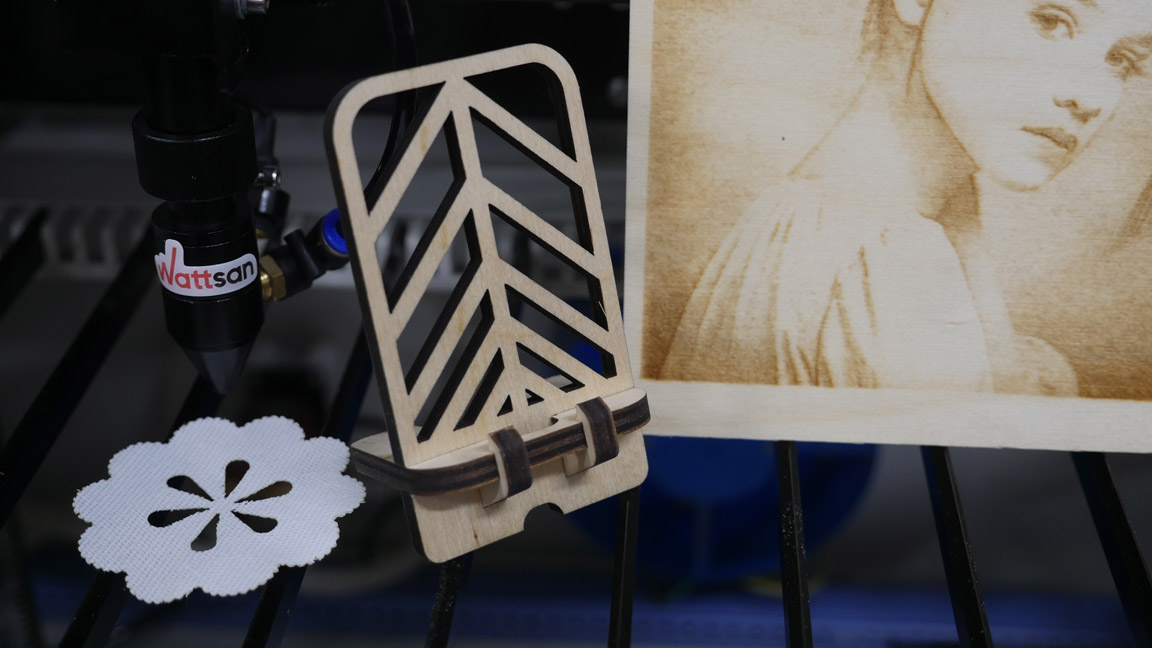
- Laser cutting speed up to 150 mm/s depending on machine and material being cut.
- The laser beam diameter at the focus point is hundredths of a millimeter, capable of piercing a hole thinner than a hair and cutting highly detailed layouts of complex configurations.
- The CNC laser is non-contact, and therefore the material does not need to be fixed on the work field, which saves working time.
- After cutting, the end face is obtained without soot, dross or taper. The laser leaves no chips and cracks or deformations on the material, unlike other machining methods,
- The CNC laser control system and software provides a wide range of tools for operation, automates the process, and minimizes the chance of defects.
- The laser cutting machine can not only cut but also engrave material. The combination of cutting and engraving makes it possible to produce more complex and sought-after products.
- The CNC laser is easy to maintain and requires almost no consumables. The CO2 laser tube lasts up to 3 years when properly operated, and the fiber optic emitter lasts up to 11 years.
What is produced with CNC laser cutting machines?
If you choose the right type of emitter and other parameters, the laser cutter will cut most materials with minor exceptions.
Materials that can be cut with a laser cutting machine:
- wood, plywood, veneer, chipboard, MDF, cardboard, paper;
- plastics and polymers: acrylic, PET, foam, rubber, paronite, and others;
- fabric, fur, leather, and faux leather;
- metals: ferrous metals, stainless metals, aluminium, titanium, copper, and others.
What kind of material a CNC laser cutter works with depends on the emitter! Some machines do not cut metal, while others do not cut wood. Read more about this in the section "emitter type"
Laser cutting machines are used both for simple cutting of material and for creating complex products.
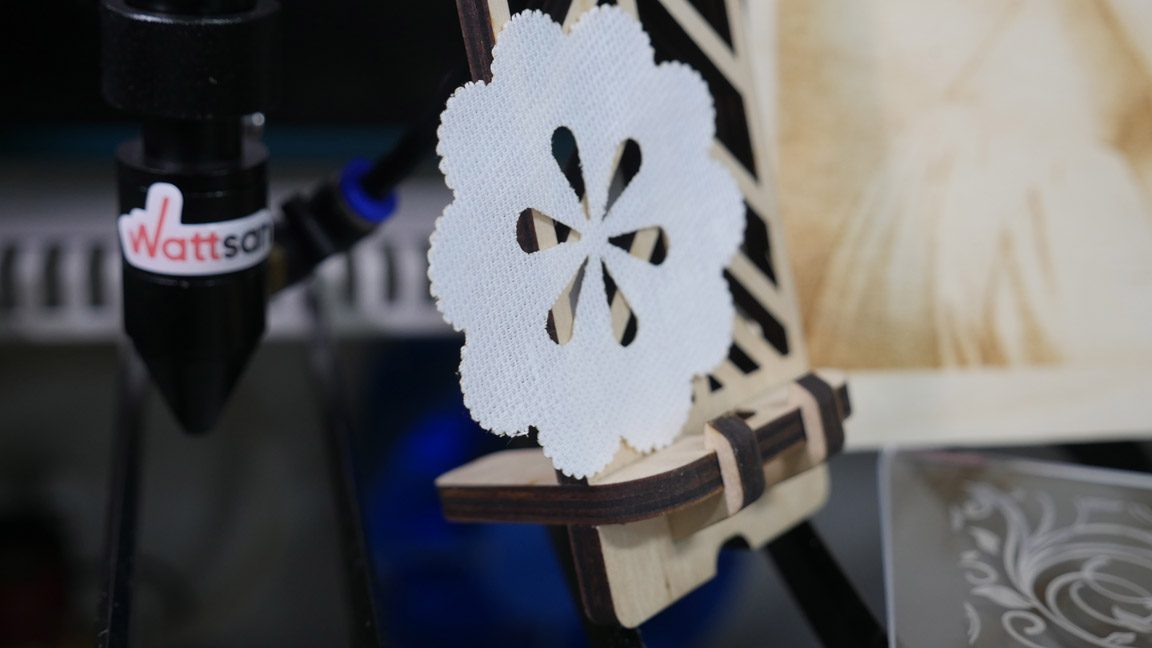
Applications for laser cutting:
- Advertising products. A CNC laser cutting machine is used to produce three-dimensional letters, signs, signage, packaging, and POS materials: showcases, displays, panels, dispensers, strip holders, bodystands, etc.
- Decorating interiors and exteriors. Laser machines are used to cut out multi-layered pictures and panels, wall maps and create three-dimensional low-poly figures, statues, lamps, backlit acrylic table lamps, decorative elements for decorating shop windows, facades, and other elements of the exterior.
- Furniture production. A CNC laser is suitable for the manufacture of composite furniture and its elements, as well as for their decoration.
- Souvenirs. Decorative key chains, personalized gifts, jewelry boxes, packaging, calendars and cards, notebook covers, and much more.
- Modeling. Making mock-ups and realistic prefabricated models with hundreds of parts has become especially popular recently.
- Educational toys. Puzzles, busy boards, figurines for coloring, Christmas decorations, board games: chess, checkers, tic-tac-toe, go, backgammon, and others, including uniquely designed games.
- Apparel production. Covers for upholstered furniture, car covers, cutting out fur without hair damage, perforating, creating clothing patterns and complex designs on textiles and leather.
- Metal cutting and producing of metal structures Fiber laser machines can cut metals up to 25 mm thick with high speed and precision.
- Steel doors production. One CNC fiber laser cutter replaces several machines in a door production facility, speeding up the manufacturing process.
- Engineering, automotive, and elevator industry. Production of housings, body parts, protective covers, spare parts, gears, and other parts in these fields.
- Production of building and finishing materials. Used for the manufacture of exterior paneling for buildings: corrugated boards, sandwich panels, metal roof tiles. The laser cutter can also be used to make fencing structures: fences and gates, including those decorated with cut-out lace elements and patterns.
- Manufacturing exhaust ventilation systems. The laser is used to cut ducts, air intakes, ventilation outlets, blades, and other elements of ventilation systems.
- Production of metal shelves, racks, and boxes. These can be cases, racks, and shelf stands, as well as advertising structures, exhibition shelving, and even tanks and containers.
- Military industry, aviation, medical racks and equipment. The high precision of laser equipment makes it possible to manufacture products, housings, and spare parts evenfor areas with the highest requirements.
- Electronics cases. Lasers can be used to cut out cases for computers and laptops, audio equipment, and other electronic goods.
How to choose a laser cutting machine. Basic criteria
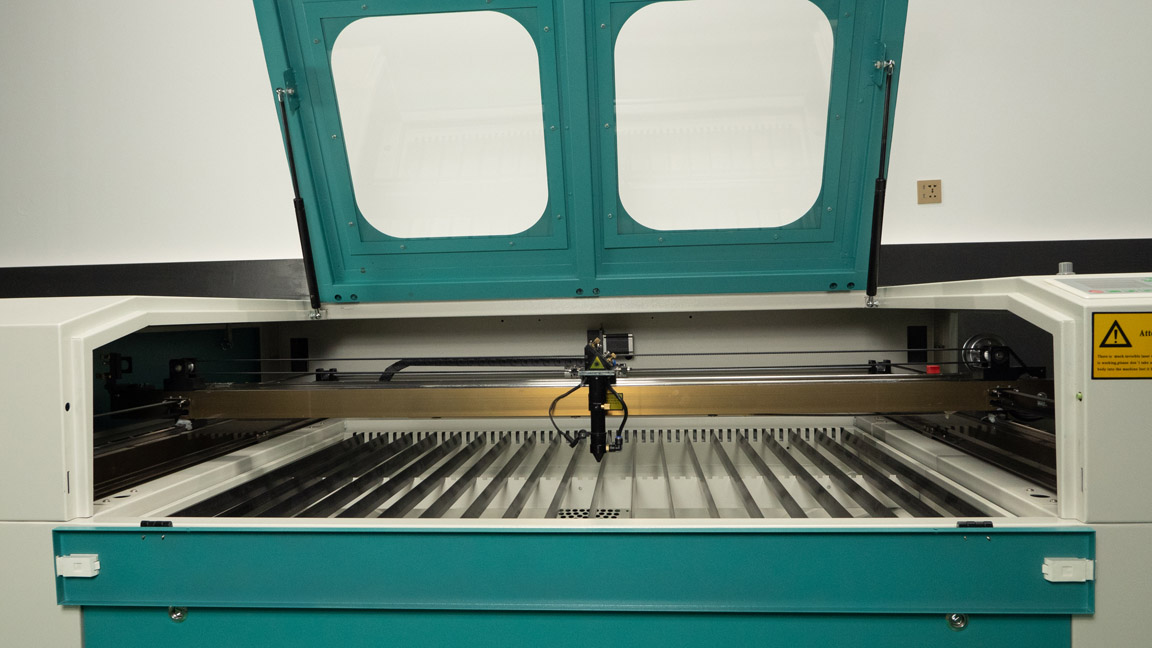
First of all, decide what you want to do with a laser machine and what materials you want to process. This will determine most of the parameters of your future laser machine and, above all, the type of laser emitter.
Laser cutting machine emitter type
Laser cutting machines are divided into two basic types: CO2 and fiber optic. The type of emission determines which materials the machine can cut.
CO2 laser cutters are capable of cutting non-metallic materials:
- wood,
- plywood,
- MDF,
- paper,
- cardboard, corrugated cardboard, foam board,
- acrylic,
- polystyrene,
- foam plastic,
- polyurethane,
- foam and isolon,
- PET and other plastics,
- fabrics,
- leather and faux leather,
- fur.
Normally, CO2 laser cutting machines are not capable of cutting metals.
An exception to this rule are the Wattsan NC series hybrid CO2 laser cutters. They cut metals up to 2 mm thick thanks to a special metal laser head, an auxiliary gas (oxygen), and laser power from 130 to 180 watts. In addition, they can cut plywood up to 15 mm and plastics up to 25 mm.
The NC-series hybrid laser cutting machines are available in two work area sizes:
- Wattsan NC 1390 with a work area size of 1300x900 mm.
- Wattsan NC 1612 with a work area size of 1600x1200 mm.
If you are interested in other work area sizes, let Virmer's manager know, and, thanks to our cooperation with Wattsan, we can produce a machine with the desired work area size.
If you are interested in learning more about CO2 laser machines, we recommend reading the article «What is a CNC CO2 laser and how it works»
Fiber laser cutting machines cut the following materials:
- ferrous metals,
- stainless steel,
- aluminium,
- copper,
- titanium,
- other metals and alloys.
It is impractical to use fiber laser cutters for other materials, as the cost of such equipment is many times higher than CO2 laser machines. In addition, because of the unsuitable wavelength, fiber lasers do not work with most non-metallic materials.
Please note that CO2 emitters for cutting are claimed to last between 3,000 and 10,000 hours (4 to 13.6 months) depending on brand and wattage, and fiber optic emitters are claimed to last up to 100,000 hours (11.4 years).
Once you have decided on the type of emission, you have to work out how much power you need.
Laser cutting machine emitter power
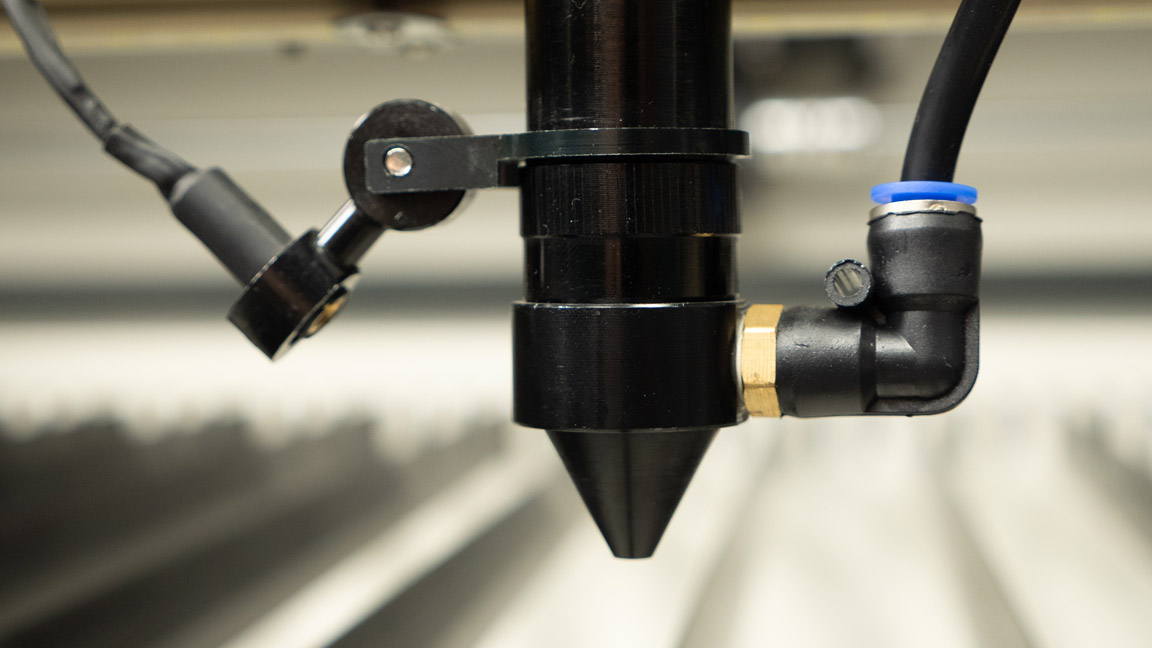
The power required depends on the thickness of the material and directly affects the operating speed.
CO2 laser cutting machine power
CO2 laser machines are designed on the principle of Flying Optics; they have a system of mirrors which reflect the laser beam using mirrors attached to various, including moving, parts of the housing. As the laser beam travels in the air, the beam inevitably scatters and loses the more of its power the greater distance it travels. For this reason more powerful laser tubes are required for machines with larger work area sizes.
For productive cutting on machines with a work area of up to 600x900 mm, emitters with a power of 40 to 120 W are used. For machines with a larger work area, laser tubes with a power of 100 to 180 W are used.
There is a "conventional" formula for calculating the power required, according to which 10 watts of power are consumed for every 1 mm of plywood thickness. For most plastics, this is conventionally 1.5 mm per 10 watts.
In order to extend the service life of the laser tube, we recommend using it at no more than 80% of its power. Keep this in mind when calculating the required power.
For example, the Reci W2 90W laser tube will cut plywood up to 8-10 mm, but the recommended maximum thickness is 8 mm.
Also note that if the laser tube has two power rates, e.g. 90-100 W, the first number is the nominal power and the second number is the maximum power. Most of the time, the laser operates at its nominal power.
Fiber laser cutting machine power
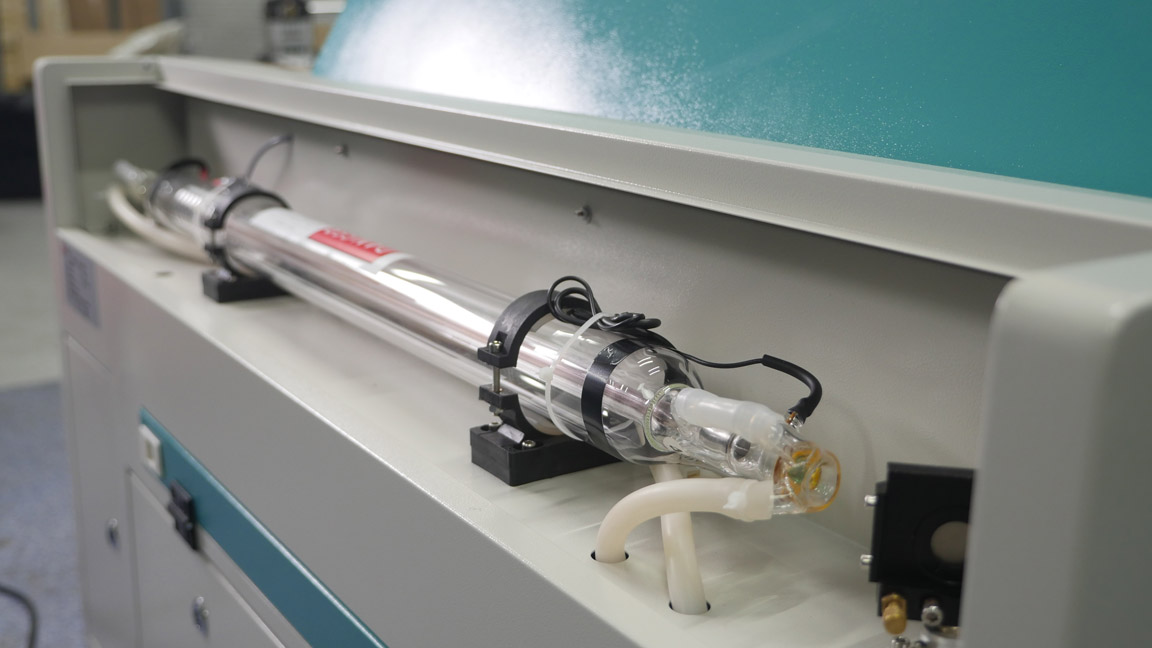
The required power of a fiber laser will depend on the thickness and the type of metal. Mirror polished stainless steel, for example, is more difficult to cut than ferrous steel, as it has a higher reflectivity.
The power of fiber optic emitters varies from 1000W to 15000W. The operating speed is not as easy to calculate as with CO2 laser machines, but there are tables that show the type of material, the laser source power, and the auxiliary gas. These tables show what thickness and at what speed can be cut with certain input parameters.
For example, a 1kW machine will cut 1 mm of stainless steel at 20 m/min. At 3kW, the same stainless steel sheet can be cut at 35 m/min, while a 6kW emitter will cut 1 mm stainless steel at 60 m/min.
Depending on the type of metal, the speed of the laser cutter will be different! In order to get help in choosing the emitter power, please contact your Virmer manager.
The next thing to consider when choosing is the size of the work area.
Laser cutting machine work area
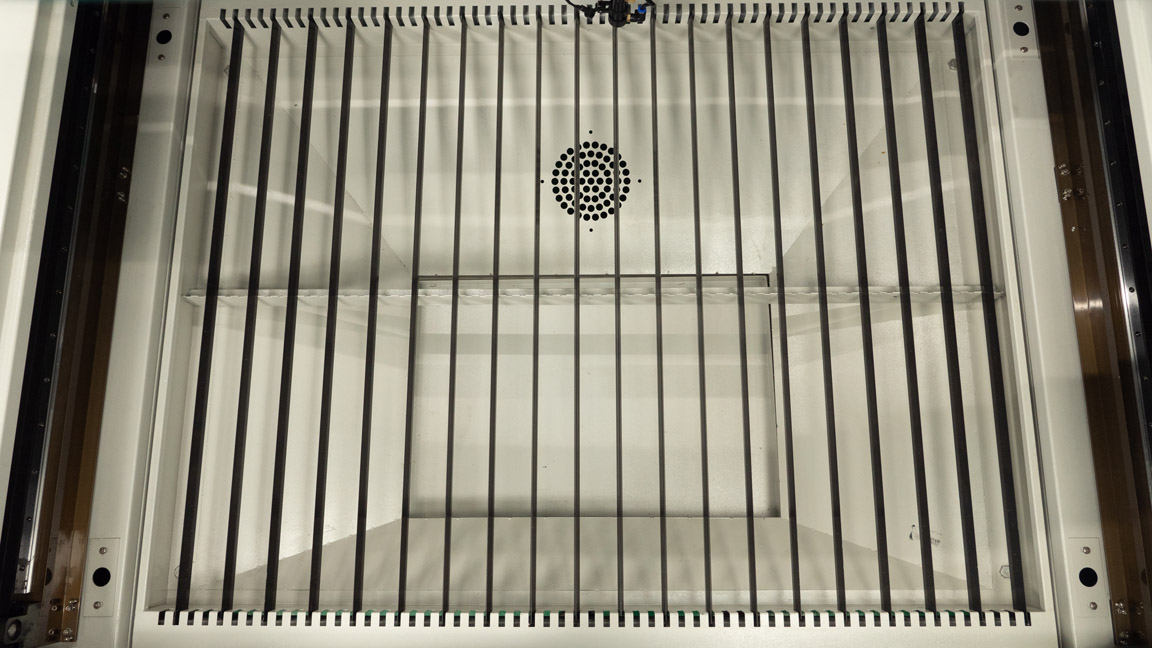
The size of the work field determines the maximum sheet size of the material you will be able to process. For example, if you want to cut corrugated cardboard boxes, then the Wattsan 2030 Flat Bed with a work field of 2000x3000 mm is the best choice, because the net of one box will be quite large. And if you need to cut packaging for small souvenirs, then the Wattsan 6090 LT with a work field of 600x900 mm will be enough.
Consider the maximum size of the final product when selecting the size of the work area of the machine.
The size of the work field will also determine whether or not you need a separate work place in the workshop to pre-cut the material. For example, the Wattsan 1610 LT large-format laser cutter has a through table with a work field width of 1600 mm. This means that you can cut sheets of most standard materials on this machine if you pull them through the through table.
The larger the work area of the laser machine, the less often you need to change material, which speeds up the production process.
To speed up the process of material change when working on fiber laser cutters, we recommend looking at machines with interchangeable tables, such as the Wattsan 1325 Tablechange.
Reliability of the machine frame, bed, and gantry
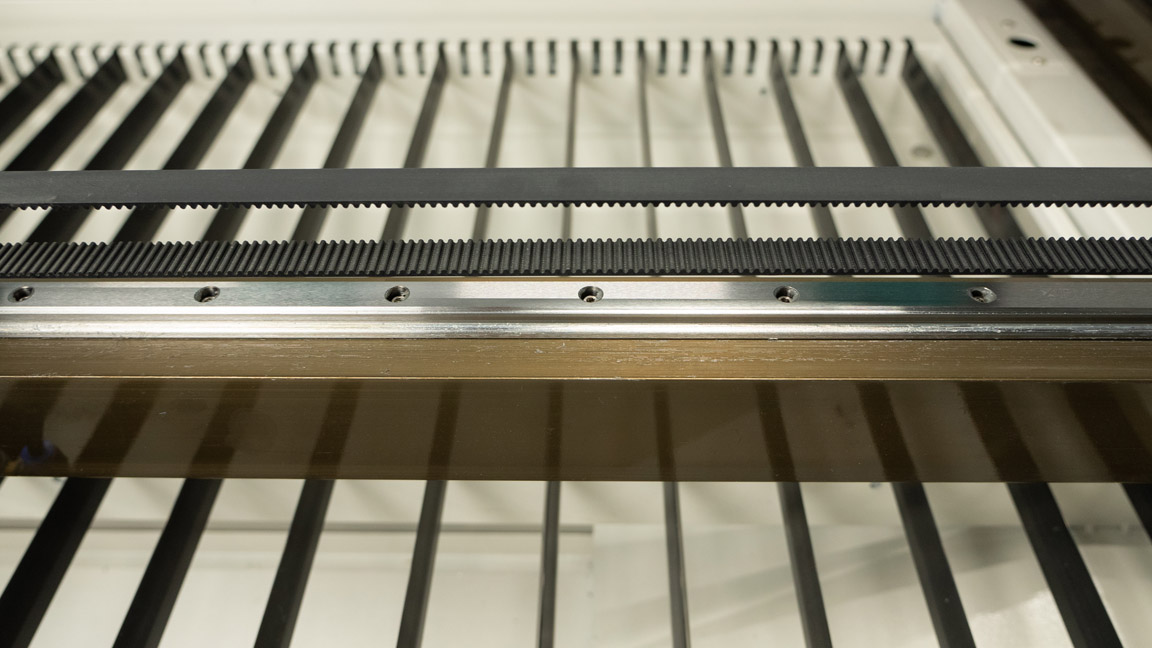
When choosing a machine, pay special attention to the design of the frame and bed of the laser cutting machine. They affect the accuracy of work, especially during continuous operation.
CO2 laser cutting machine frame
CO2 laser cutting machines must have an internal reinforcement frame. It is quite difficult to see it without disassembling the entire machine, but its presence can be easily checked - try shaking the machine with your hands. A model with an internal reinforcement frame is virtually impossible to shake by hand. If there is no frame inside, the machine will wobble.
The lack of internal frame reinforcement leads to a rapid drop in cutting accuracy.
CO2 laser cutting machine bed
The reliability of the machine is also affected by the housing itself, that is, the housing material and its thickness. The best solution for the housing is steel with a thickness of at least 2 mm. On Wattsan CO2 laser machines, for example, the bed thickness is 2.9 mm.
CO2 laser cutting machine gantry
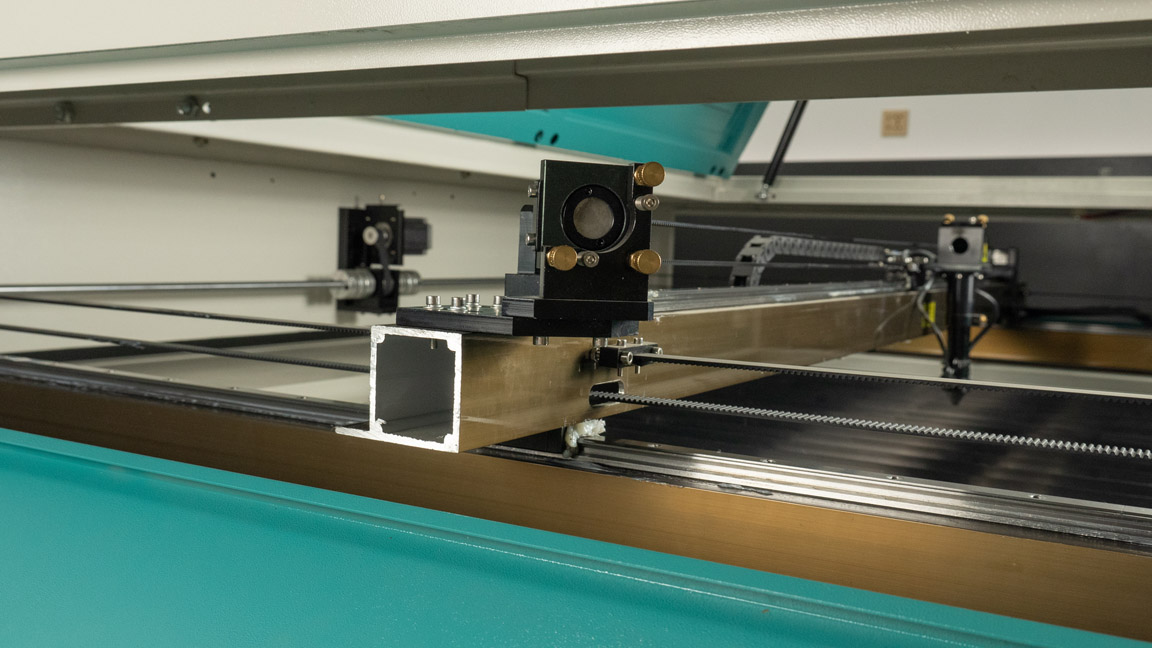
The next element of the machine that is subject to constant loads is the gantry, because it is where the working head is attached. The thickness of the gantry can easily be checked by opening the side cover of the machine. A thin gantry will deform over time, which reduces accuracy and repeatability of work.
With a profile gantry up to 7 mm thick, a robust housing, and frame construction, Wattsan machines are designed to work around the clock. They have a service life of over 10 years without loss of precision.
Fiber optic laser cutting machine frame and gantry
A laser machine for metal cutting is subject to much more load, from the weight of the material itself to the idle movements of the portal at a speed of up to 120 m/min.
A metal laser machine must not only withstand the load of material and movements of the laser head, but also eliminate vibrations so that work accuracy is not compromised.
Wattsan laser metal cutting machines have an all-welded frame with a cross section of rectangular pipes up to 10 mm. Inside the frame there are reinforcement baffles every 400 mm. To relieve the stress on the metal, the finished frame is annealed in a special furnace with strict temperature control.
The metal laser machine gantry is more solid compared to CO2 machines. The best modern solution for a fiber laser machine would be an aluminium profile gantry; it is lightweight, robust, and not subject to oxidative processes.
Operating speed
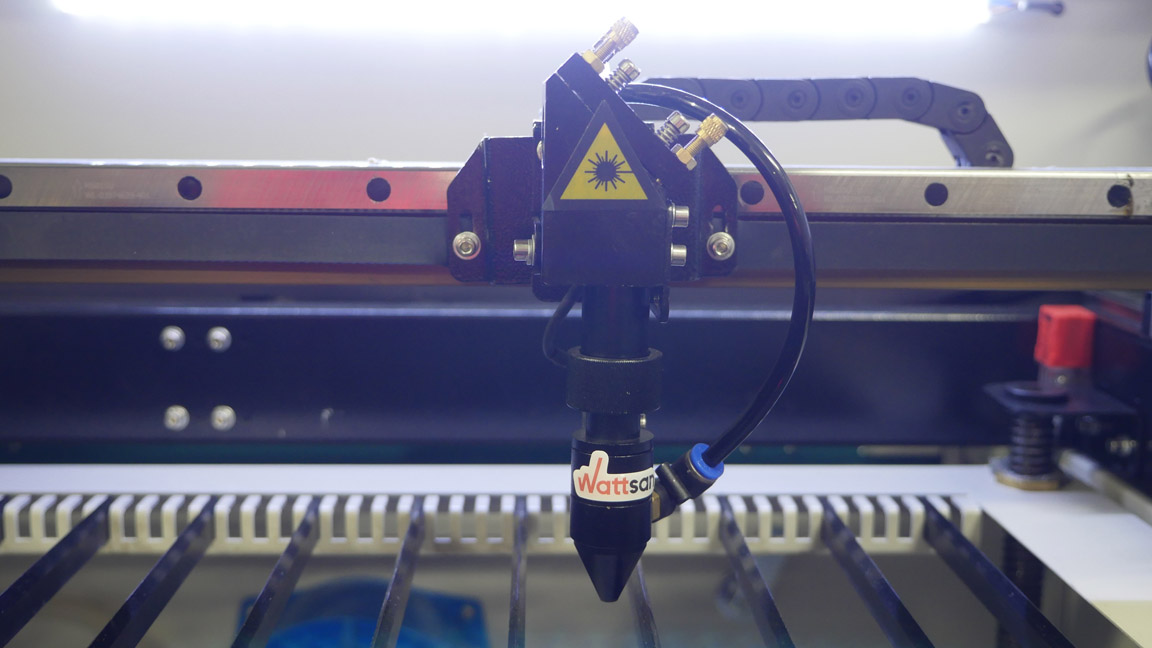
When it comes to the speed of laser cutting machines, it is important not to confuse speed of operation with idle speed. Generally, operation occurs at much lower speeds than idling. For example, the idle speed of a CO2 laser machine reaches 500 mm/sec, but you will cut 3 mm thick plywood at about 35 mm/sec, depending on the power of the emitter.
Laser cutting speeds will vary, depending on the material, its thickness, and the power of the laser emitter.
All of the above is also true for fiber optic lasers. But for this type of equipment, the idle speed is more important for some tasks. For example, if it is necessary to cut holes in the corners in the sheathing of any metal structures, in this case the machine needs to move around the entire work field from corner to corner, and the operation speed will directly depend on the speed of idling and acceleration.
Complete set of a laser cutting machine
CNC lasers are complex equipment in terms of machine tool building, and all the difficulties, as always, lie in the details. The most important thing is to calculate the loads and choose all the components correctly so that they fit each other and the loads.
For example, the Wattsan fiber laser cutting machines are equipped with Mitsubishi servo motors. It would seem that this is already good, because this is a reliable brand, and its mere presence speaks of the quality of the machine. But no, if the rest of the machine components are not designed for the loads that these engines will give, then such a machine will not last long.
Wattsan engineers have been designing, manufacturing, and refining their machines for more than 20 years.
This allows the company to take a strong position in the market and be responsible for their machines. All machine components are carefully designed and tested under maximum loads. Everything, from the engine to the end sensors, has been chosen according to the principle of sufficiency, which means that the best possible parts have been selected to complete the machine, without chasing after expensive brands.
If you would like a thorough consultation, call: +31208082045 or е-mail: info@virmer.com.
Software
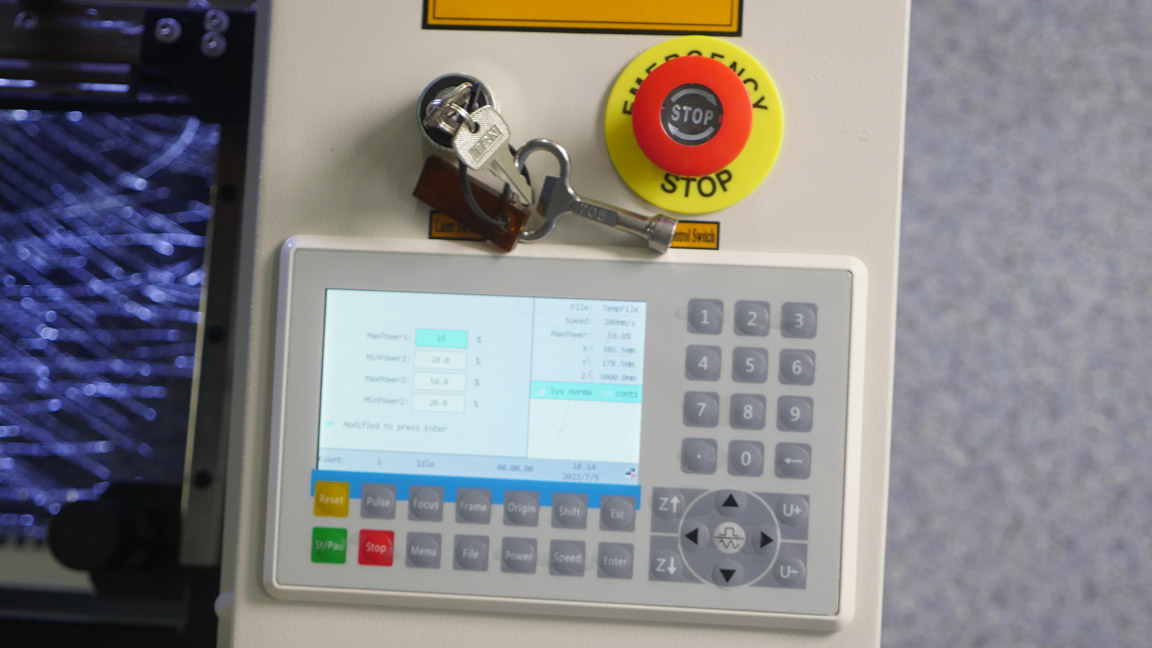
Laser cutting programmes are usually not very difficult to learn. However, without experience, it will be difficult to master all the functions and it may take considerably longer than if you learn from professionals. Therefore Virmer recommends training with our engineers.
You can receive training when commissioning the machine or book a full in-depth training course.
Check with our managers for more information by: +31208082045, е-mail: info@virmer.com.
The last thing to consider when buying a laser machine is the reliability of the supplier.
Supplier reliability and support. How to evaluate
When buying a machine it is important not only to get a quality product, but also to be sure of the supplier's support should you need it. The main characteristics that speak for reliability are experience and production volumes, warranty and service, as well as commissioning and training.
Manufacturing experience
Pay attention to those who have been in production for a long time. It is these companies that value their reputation and, thanks to their experience, know how to make really high-quality equipment.
Production volumes
High quality equipment is inevitably in demand. Find out how many machines the manufacturer sells and in which regions. Doubts may be caused by small production volumes and local limitations of the supplier.
Warranty and service
Specify whether the supplier will be able to implement its warranty obligations in your region and whether it has post-warranty services.
Commissioning and training
Setting up a laser machine is not too difficult, but it is definitely not a task for someone without experience. Check if the supplier can provide commissioning, and if he has a training service for the machine.
Virmer is ready to send engineers anywhere in Europe to help you with your tasks.
Top CNC laser machines for cutting
It is difficult to determine which CNC laser cutting machine is needed outside the context of its use. Therefore we have highlighted the top machines depending on the material to be processed.
The best cutting machines for plywood, wood, and wood-based materials (MDF, veneer, cardboard, cork, etc)
Wattsan 6090 LT CO2 laser machine
The size of the work area is 600x900 mm, the power of the laser tube is 90-100 W. It is equipped with an automated lifting table that can be lowered by 160 mm, which allows you to work with thick material, for example, with wood, as well as to install a rotary device for machining cylindrical workpieces. Suitable for small or medium series production. Designed for 24-hour workload throughout the entire service life of the machine.
This model costs around € 5 213, for the relevant price and details of the machine, visit our website.
Wattsan 1610 Duos LT laser cutting machine
Is notable for increased productivity due to two laser heads working simultaneously. This design doubles the speed of production. The size of the work area is 1600x1000 mm, and the through hole in the housing at worktable level allows you to pull materials of any length and width up to 1600 mm, for example, a standard sheet of plywood.
The Wattsan 1610 Duos LT laser cutter is designed for medium and large-scale production lines.
The Wattsan 1610 Duos LT costs around €9 151 , for the relevant price and details of the machine, visit our website.
Wattsan CO2 laser machines are designed specifically for continuous round-the-clock work. Virmer is the official dealer of the Wattsan factory in Europe.
The best laser cutting machines for plastics (acrylic, PET, polypropylene, etc.)
Wattsan 1290 ST medium-format laser cutting machine
This model is equipped with a static table and is therefore marked ST. The static table cannot be lowered and cuts materials up to 40 mm thick. However, in most cases this is sufficient for working with plastics. The exception is foam rubber or foam, and then pay attention to Wattsan machines marked LT (Lifting Table). Also, on request, we can equip the machine with a second working head to speed up work.
The machine costs around €6 043, for the relevant price and details of the machine, visit our website.
Wattsan 2030 Flat Bed large-format laser cutting machine
The work field size of 2000x3000 mm allows you to work with plastic sheets without pre-cutting. This saves time and space in the workshop. The machine is designed for the manufacture of large items or for large-scale production of small items. Even with this large work area, the Wattsan 2030 FlatBed maintains its accuracy throughout its service life thanks to the experience and development of Wattsan's design engineers.
This model costs around €16 747, for the relevant price and details of the machine, visit our website.
CO2 machines are also suitable for cutting textiles, leather, and leatherette. But they cannot cut metals.
The best laser machines for cutting metals
Wattsan 1325 Basic fiber optic laser metal cutter
This is the basic model of CNC metal laser machines. The size of the work field is 1300x2500 mm, the power is from 1000 to 2000 watts. A protective cabin is required for machines above 1000W. Positioning accuracy: 0,02 mm; idle speed: 60 to 80 m/min. The operating speed depends on the power and metal thickness and is up to 60 mm/s.
Check the relevant price with Virmer managers: info@virmer.com; what’s app +31208082045. More information about this model can be found on our website.
Wattsan engineers have been designing, testing, and refining machines for more than 20 years. This extensive experience has enabled them to come up with the most successful design solutions: all components are matched to the loads, the all-welded reinforced frame is annealed to relieve stress on the metal, the servomotors with the planetary gearboxes eliminate vibration, the 20 mm HIWIN guides are responsible for positioning accuracy.
Wattsan 1530 Rotatory fiber optic laser metal cutter
The power of the machine is 1000 to 6000 W, and the work area of 1500x3000 mm accommodates all types of sheet material. The machine is equipped with a rotary device, and therefore in addition to cutting sheet metal, it also cuts round and rectangular pipes.
The cost of the machine depends on the emitter power and the rest of the equipment. Check the relevant price with Virmer managers: info@virmer.com; what’s app +31208082045. More information about this model can be found on our website.
Wattsan 1325 Tablechange fiber optic laser metal cutter
This model is notable for the interchangeable tables. When the main table is used to cut material, the second table is used to collect the already cut metal pieces and to load a new metal sheet. This speeds up the process, making this machine ideal for high volume production.
The cost of the machine depends on the emitter power and the rest of the equipment. Check the relevant price with Virmer managers: info@virmer.com; what’s app +31208082045.
Fiber optic CNC laser machines for cutting metals with a power of more than 1 kW must be equipped with a protective cabin. Virmer provides emitters up to 15 kW.
The best universal laser cutting machine for different materials
Most often, CNC lasers are geared to a specific material: either metals or non-metals. However, there is a hybrid laser cutting machine based on a CO2 CNC laser.
Wattsan NC 1612 hybrid laser cutter
Unlike conventional CO2 lasers, it is equipped with a special working head designed for cutting both non-metals and metals. In addition, it differs from other CO2 laser cutters by having two control systems, the Ruida RDC6332M and the Ruida Live Focus System. The first one is responsible for X-axis and Y-axis movements, and the second one for Z-axis positioning.
This machine can cut metals up to 2 mm thick, but only with an auxiliary gas (Oxygen), plywood up to 15 mm, and plastics up to 25 mm, as well as other non-metallic materials.
This model costs around €13,760, for the relevant price and details of the machine, visit our website.
Please note that the hybrid laser cutting machine is not suitable for metals thicker than 2 mm.
The best laser cutting machine for textile and roll materials
1610 Duos Conveyer laser cutting machine for fabric
This machine is specially designed for cutting textiles and other coiled materials. It has a conveyor table and two cutting heads to speed up the production process. The conveyor table allows the material to be pulled through and fed into the cutting area to work uninterruptedly.
The machine costs around €11 375.
It is also possible to equip the machine with a camera, which helps to recognise contours and work with marks, which simplifies and speeds up the work process.
This model costs around €15 800
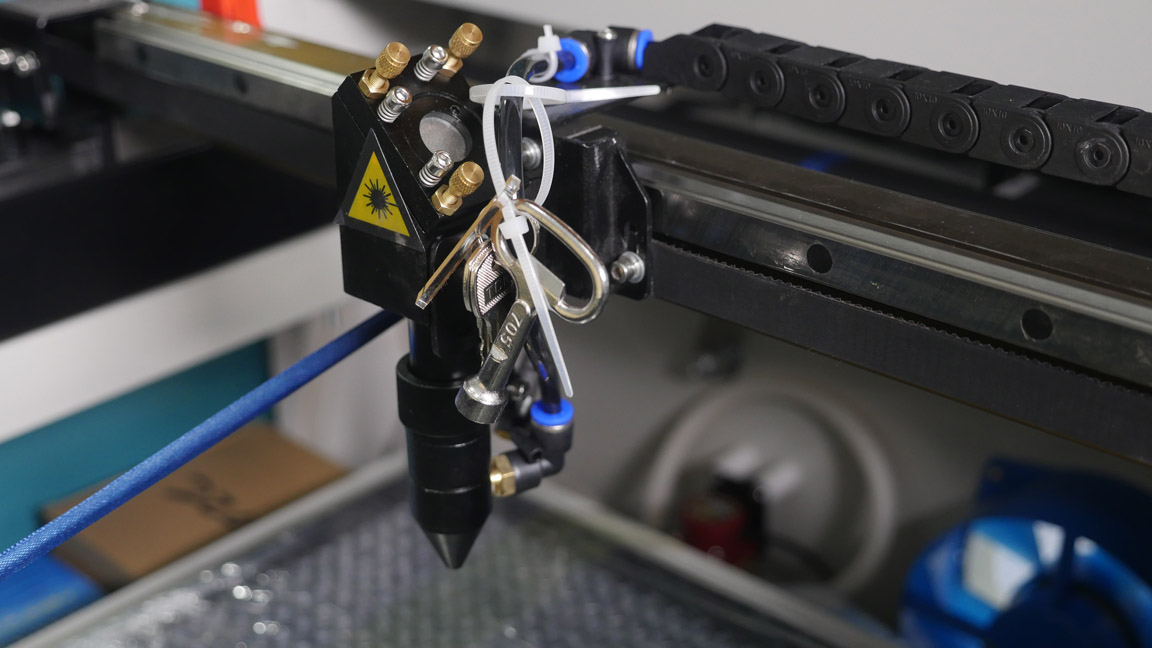
Conclusions
As you can see, choosing a machine is not an easy task and depends largely on your tasks and requirements. If you need an online demonstration of the equipment mentioned in this article, or further advice, please call us: +31208082045 or email us at info@virmer.com.
In addition to lasers, CNC milling machines can also be used to cut different materials. They can cut wood materials without carbon deposits, and they also have a number of advantages compared to a laser. Read more in our article "How to choose a CNC router".
FAQ
How much does a laser cutting machine cost?
The cost of a laser cutter depends on its work field size, laser source power, and other characteristics. The price for a CO2 laser cutting machine is 1,370 to 16,750 € , more details on our website. Laser metal cutting machines can be found on this page. The price of a metal laser machine is highly dependent on the emitter you choose, so please check with our managers.
What is a CO2 laser cutting machine?
A CO2 laser machine is a numerically controlled machine that can cut and engrave quickly and precisely non-metallic materials such as plywood, wood, MDF, various plastics, textiles, leather, fur, and many other materials using laser emission.
What kind of wood can be cut with a laser?
With a laser cutter with a carbon dioxide (CO2) emitter, you can cut any kind of wood. The recommended thickness for this type of cutting is up to 10 mm, as laser exposure to greater thicknesses causes fouling on the cut.
What is the difference between CO2 laser and fiber optic laser?
The difference between a CO2 and fiber laser is the wavelength of laser emission. With CO2 lasers it is 10.6 µm, while with fiber lasers it is 1.06 µm. The wavelength determines the possibility of treating particular materials.
CO2 lasers can work with wood, plywood, veneer, MDF, cardboard, paper, and other wood materials, plastics and polymers, such as: PET, acrylic, rubber, foam rubber, paronite, and others, with fabrics, leather, leatherette, and fur. In addition to cutting, CO2 laser machines can also engrave ceramics, stone, glass, and mirror.
Fiber optic machines work with ferrous metals, stainless steel, aluminium, titanium, copper, brass, and precious metals. Also, they are capable of working with polymers and plastics, some types of leather and faux leather.
What can be done with a laser cutting machine?
The laser cutter can be used to cut almost any thickness of material. For non-metallic materials, CO2 laser cutters are intended, and for metals - fiber optic laser cutters.
